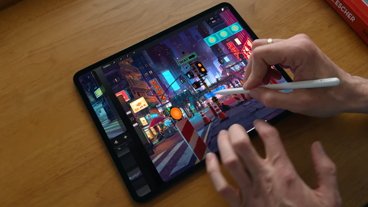iPad news advertisements command 5 times more than Web ads
While the news doesn't quite mean the iPad will "save" print publishing, as online advertising is a fraction of what publications receive in print, it is a sign that the iPad could become a major factor in revenue for those in the news business, according to the Associated Press.
The report from Andrew Vanacore said it's likely that news organizations will hold back free content from their websites in the future, opting instead to provide news to users who subscribe on tablet-style devices like the iPad. And although Apple has already sold 2 million iPads, the market will have to become much larger for it to have a major effect on a news organization's bottom line.
JPMorgan Chase & Co., which was the exclusive advertiser of the New York Times application for the first 60 days, also revealed that the click-through rate for iPad advertisements is a remarkably high 15 percent. The report noted that the online average for people viewing an advertisement is about one-tenth of a percent.
iPad readers also spend a great deal more time with content. Publisher Conde Nast revealed that the average reader spends 60 minutes with a monthly issue on Apple's device, compared with the average website visit length of less than 5 minutes per month.
One of the biggest problems with online advertising is the unlimited amount of space available. In a newspaper or magazine, space is finite based on the number of printed pages, adding more value. Online, limitless space makes advertising less valuable. The AP also noted that online ad networks allow advertisers to get placement at discounted rates. But the supply-and-demand issues haven't yet appeared in the iPad, which has been on the market for just over two months.
"In iPad applications such as USA Today's, there is a finite amount of space and no ad networks are in the mix," the report said. "And the app gives advertisers new possibilities. A reader can click on Courtyard by Marriott's USA Today ad and then with a flick of a finger scroll through images of the hotels' updated lobby design. Another tap and a high-definition video appears, full of happy hotel guests."
Jason Fulmines, director of products for USA Today owner Gannett, said the publication charges Mariott about $50 for every thousand ad impressions, while the going rate on the newspaper's website is less than $10.
But while the numbers are better on the iPad, they're still not as strong as they are in the newspaper. The cost per thousand in the print product, which is distributed nationally, runs $103 — more than twice that of the iPad and ten times that of the website.
More evidence of the premium nature of the iPad, with respect to advertisers, will come with Apple's own iAd mobile advertising network. Early reports have suggested that Apple intends to charge as much as $10 million for companies to have initial placement in the iAd network. After the launch, Apple reportedly aims to charge close to $1 million for ads on its mobile devices — much higher than the $100,000 to $200,000 companies pay with existing mobile deals.
Publishers, too, have made great investments in bringing their content to the iPad, and so far it's been a positive. The AP noted that The New York Times had more than 300,000 downloads of its free newspaper application by mid-May. A few weeks earlier, Apple had announced iPad sales had topped 1 million, suggesting a very high number of iPad owners downloaded the Times application.
The recently released $4.99 iPad edition of Wired, a Conde Nast publication, quickly jumped to the top of the App Store sales chart. The magazine utilizes new digital publishing technology developed by Adobe, which allows the print publication to work on an iPad edition at the same time, and add in interactive content such as video and animated graphics.
 Katie Marsal
Katie Marsal











 Charles Martin
Charles Martin
 Christine McKee
Christine McKee
 Andrew Orr
Andrew Orr
 Wesley Hilliard
Wesley Hilliard
 Malcolm Owen
Malcolm Owen

 Amber Neely
Amber Neely
 William Gallagher
William Gallagher








36 Comments
In the UK the Times newspaper app has sold 5000 copies in the last 7 days, they charge £10 (around $15) a month for access, that's damn good money already and will only increase as more ipads are brought into the UK!
I know that advertising is a great source of revenue (look at Google)...
And I understand that if content providers can command high add prices it bodes well for content on the iPad...
...But I still can't get excited about it.
Yea, because the users of iPads can't install software or browser plugins to block the ads.
Kinda sucks losing control over one's hardware huh?
One of the biggest problems with online advertising is the unlimited amount of space available. In a newspaper or magazine, space is finite based on the number of printed pages, adding more value. Online, limitless space makes advertising less valuable.
"In iPad applications such as USA Today's, there is a finite amount of space
Damn. Some people will believe anything.
Magazines have different numbers of pages. They can include unlimited numbers of ads. Remember Byte? Remember how thick it was? Ever seen the special yearly issues of Vogue?
Apps can expand and contract. Who knows, maybe the next issue of WiReD will contain a few more ads? Or maybe less?
And web pages do not have unlimited space. They need an appealing ratio of advertising to content, or else they lose readers.
The reasoning parroted in this story is all total bullshit.
Yea, because the users of iPads can't install software or browser plugins to block the ads.
Kinda sucks losing control over one's hardware huh?
I don't see the ads?! Oh... that's because I don't visit print publications repurposed for Apple's iPad!
Guess I do have some control after all!
Just like I don't by Nike's extortion priced shoes so they can pay royalties to an already rich athlete for a product that does what? Cover feet... FEET! New Balance works fine for me! Still lov'in that control!